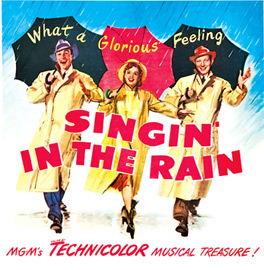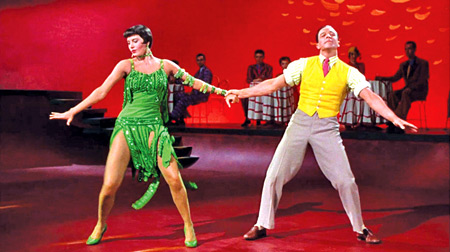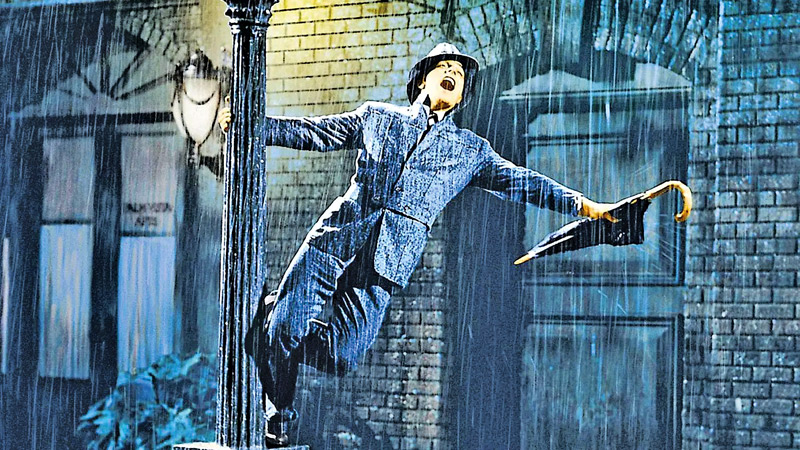“Singin’ in the Rain” isn’t just a movie; it’s a cinematic masterpiece that encapsulates the magic of Hollywood’s Golden Age.
 Directed and choreographed by the legendary Gene Kelly and Stanley Donen, this 1952 American musical romantic comedy transcends mere entertainment to become a cultural touchstone, celebrated for its unparalleled craftsmanship and enduring charm.
Directed and choreographed by the legendary Gene Kelly and Stanley Donen, this 1952 American musical romantic comedy transcends mere entertainment to become a cultural touchstone, celebrated for its unparalleled craftsmanship and enduring charm.
Set in the bustling world of 1920s Hollywood, “Singin’ in the Rain” follows the journey of Don Lockwood (portrayed by Gene Kelly), a charismatic silent film star, and his friend Cosmo Brown (played by Donald O’Connor), as they navigate the tumultuous transition from silent films to “talkies.”
Memorable songs
Along the way, they encounter the spirited Kathy Selden (brought to life by Debbie Reynolds), whose passion for theater and disdain for film acting add an intriguing dynamic to the narrative.
 From its dazzling opening sequence to its joyous finale, “Singin’ in the Rain” delights audiences with its infectious energy and memorable musical numbers. Gene Kelly’s iconic performance of the titular song, dancing joyfully through the streets amidst a downpour, has become an enduring symbol of cinematic bliss. Donald O’Connor’s show-stopping rendition of “Make ‘Em Laugh” showcases his unparalleled comedic talent, while Debbie Reynolds shines in her breakout role, infusing the film with her youthful exuberance and grace.
From its dazzling opening sequence to its joyous finale, “Singin’ in the Rain” delights audiences with its infectious energy and memorable musical numbers. Gene Kelly’s iconic performance of the titular song, dancing joyfully through the streets amidst a downpour, has become an enduring symbol of cinematic bliss. Donald O’Connor’s show-stopping rendition of “Make ‘Em Laugh” showcases his unparalleled comedic talent, while Debbie Reynolds shines in her breakout role, infusing the film with her youthful exuberance and grace.
But beyond its dazzling dance numbers and catchy tunes, it is a film with depth and substance. It offers a satirical glimpse into the inner workings of the film industry, lampooning the egos, vanities, and insecurities of Hollywood’s elite. Jean Hagen delivers a scene-stealing performance as Lina Lamont, the self-absorbed leading lady whose grating voice threatens to derail the transition to talkies.
Witty dialogue
The film’s screenplay, penned by Betty Comden and Adolph Green, brims with wit and charm, weaving together humour, romance, and nostalgia in equal measure. Each line of dialogue crackles with wit, and each musical number resonates with emotion, creating a rich tapestry of storytelling that captivates audiences from start to finish.
Critics have heaped praise upon “Singin’ in the Rain,” lauding its craftsmanship, performances, and enduring legacy. Bosley Crowther of ‘The New York Times’ hailed it as “a riotous abundance of music, dance, color spectacle,” while Variety praised its “pace, humor, and good spirits.” Pauline Kael, the esteemed film critic for The New Yorker, declared it “the most enjoyable of movie musicals” and “just about the best Hollywood musical of all time.”
Since its release, “Singin’ in the Rain” has achieved iconic status, revered by audiences and critics alike as one of the greatest films ever made. Its inclusion in the AFI’s Greatest Movie Musicals and the Library of Congress’s National Film Registry further solidifies its place in cinematic history.
“Singin’ in the Rain” is a timeless classic that continues to enchant and inspire audiences with its boundless creativity, infectious charm, and timeless appeal. It’s a celebration of the magic of cinema and a testament to the enduring power of music, dance, and storytelling.









